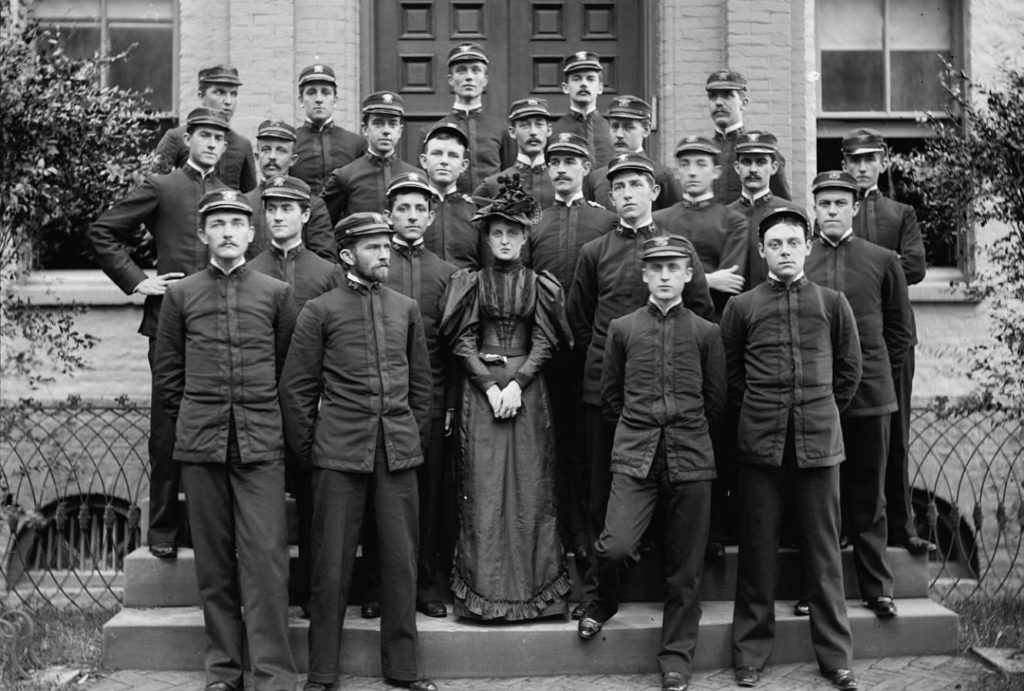Are You Smarter than a 19th Century Midshipman?

The summer is coming to an end, despite the fact that Washington D.C. and the environs still feel like a swamp. In the first century of the capital’s existence the city would still be largely abandoned this time of year. We know the summer is coming to an end, however, because fall term is upon us at many colleges and universities inside and near the beltway. In Annapolis, the Brigade of Midshipmen have returned to the U.S. Naval Academy from their summer training duties with the Fleet and classes began this week.
Recently, while researching in the Academy’s Nimitz Library overlooking College Creek where it meets the Severn River, I came across the record of the final exams for the 1881 and 1882 school years on “The Yard.” In those days, the first history class that Midshipmen took from the professors in the Department of English Studies, History, and Law was U.S. History. (Today we have a separate history department and Midshipmen must start with American Naval History.) That year the Fourth Class Midshipmen, also known at the service academies as Plebes (freshmen at civilian institutions), would have been the Class of 1885. The class included future Chiefs of Operations Admirals Robert Coontz (CNO #2) and Edward Walter Eberle (CNO #3), as well as future Senator from Nebraska Robert Beecher Howell.
The Class of 1885 were born during the Civil War, and grew up in the political and social turmoil of the Reconstruction Era. They would enter the fleet just as American interest in the world was beginning to increase, the very summer that Alfred Thayer Mahan was promoted to Captain and began writing his lectures for the new Naval War College. Many would go on to serve as junior officers in the Spanish-American War.
A century ago the United States was debating its role in the Great War, and this generation of naval leaders served as the officers in tactical command of the eventual war effort.
So what did the professors think a young naval officer needed to know about U.S. History at the start of the 1880s? The United States was looking outward again and returning to world affairs after two decades of relative isolationism, and the Navy was starting to build modern and capable warships after decades of decay. Not surprisingly for its time and place, the U.S. History course had a strong military and political basis. Thus, the exam contained little of the economic, social, or cultural history that students might find today. Though, students in 2016 might have some renewed insight into the “leading points in the character, career, and political views” of Alexander Hamilton and Aaron Burr. And, of course, that observation might lead to the provocative question: Could you pass the test today?
——————————————————————————–
Fourth Class Year
Department of English Studies, History, and Law
UNITED STATES HISTORY
June, 1882. — Time allowed, four hours.
Editor’s Note – Other exam outlines have the following notation explaining duplicate questions: “[Starred questions are alternatives.]”
1. Give an account of any three of the following: (1) The settlement of Georgia. (2) The loss of New Netherlands by the Dutch. (3) Jay’s Treaty. (4) The Ostend Manifesto. (5) The Crittenden Compromise.
2. Explain the origin, purpose, and scope of the Monroe Doctrine.
3. Explain the causes of the War of 1812, as shown in the events of the ten years preceding. Show how these causes were connected with the general policy of the government and with the condition of parties. How far did the war secure the objects for which it was begun?
4. Give some account of any five of the following: (1) Marquette. (2) Charles Lee. (3) Montcalm. (4) S.A. Douglas. (5) Farragut. (6) Jackson. (7) Genet.
5. During what years were the Articles of Confederation in operation? What were the essential differences between the Articles of Confederation and the Constitution that replaced them?
*5. Compare the leading points in the character, career, and political views of any three of the following: Hamilton, Jefferson, Burr, Clay, Calhoun, Webster.
6. Give an account of General Scott’s campaign from Vera Cruz to the City of Mexico.
*6. “American history is a history of compromises.” Show that this is true, and describe briefly the compromise of 1850.
7. Fix the position of the following places, and describe briefly the event that gives each of them historical importance: (1) Lexington. (2) Camden. (3) Monmouth. (4) Germantown. (5) Ticonderoga. (6). Yorktown.
8. Describe the career of the Alabama, and give the history of the settlement of the Alabama claims.
9. Draw a map of Maryland and Virginia, noting the position of the following:
- Richmond.
- Washington.
- Rappahannock River.
- Hanover C.H.
- Manassas Junction.
- Malvern Hill.
- Fredericksburg.
- Shenandoah Valley.
- Chancellorsville.
- Chantilly.
- Fortress Monroe.
- Potomac River.
- James River.
- Spotsylvania C.H.
- York River.
- Bull Run.
- Pamunkey River.
- Petersburg.
- Harper’s Ferry.
- Weldon Railroad.
- Antietam.
10. Give any points of importance that you may remember in reference to the battles of Fredericksburg, Chancellorsville, Bull Run, and Gettysburg, stating especially the date, the names of the commanders, and the character and results of the battle.
Source: Examination Papers: United States Naval Academy, 1881-82 (Washington DC: Govt Printing Office, 1883.)
——————————————————————————–
BJ Armstrong is an active duty naval officer reading for his PhD with the Department of War Studies, King’s College, London. He is a Senior Editor with War on the Rocks and series editor of the “21st Century Foundations” books from the Naval Institute Press which include his books 21st Century Mahan and 21st Century Sims.
Image: Library of Congress

